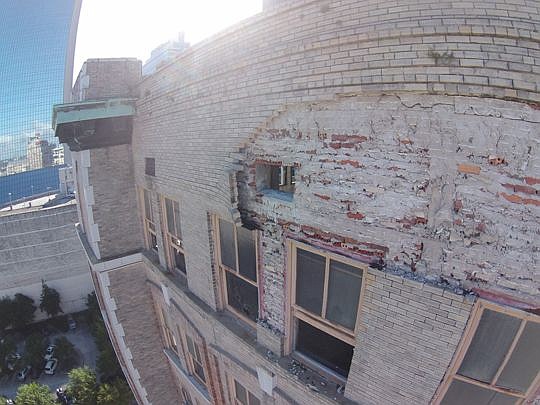
If you were Downtown Thursday, looked up in the sky and saw something that didn’t fit into the norm, it wasn’t a bird, it wasn’t a plane and it wasn’t Superman.
It was an unmanned aerial vehicle — often referred to as a drone — being used to inspect the exterior of the former Barnett Bank Building and Laura Street Trio.
Rob Mauro, an engineer who works out of the Miamisburg, Ohio office of Danis Construction Co., travels the country to record high-resolution still images and high-definition video of job sites and projects.
Danis is the general contractor for the historic restoration and adaptive re-use project proposed for the four buildings along Laura Street at Adams Street.
The company was the contractor for the restoration of the Haverty’s Building, now the Jake M. Godbold Annex; the Kress Building, now the Farah & Farah Building; and the former Haydon Burns Public Library, now the Jessie Ball duPont Center.
Using the drone is faster and safer than other methods of visual inspection, said Danis Vice President Tony Suttles.
The company will document the exteriors of the buildings in two days, but safety is the primary purpose for using the drone.
“There are bricks falling off these buildings. This is a lot safer than climbing up the outside of the building or climbing down from the roof,” he said.
Mauro said Danis is one of a few companies granted an exemption from the FAA for commercial operation of a drone.
The drone he operates — a DJI Phantom 2 Vision — is an off-the-shelf unit.
“It’s totally stock because the FAA prohibits modifications,” Mauro said.
The FAA established requirements for operating a drone for commercial purposes, such as the craft must remain in the line of sight of the operator with vision unaided by any device other than corrective lenses and it must be used only between sunrise and sunset.
The drone must not exceed 400 feet above ground level and it must yield right-of-way to all other aircraft, manned or unmanned.
The operator is required to notify airports or heliports within 5 miles of the flight plan area and hours of operation.
A former Marine Corps Cobra attack helicopter pilot, Mauro said Downtown is in a “buffer zone,” just outside the 5-mile limit for Jacksonville International Airport and Jacksonville Naval Air Station, so no notice was required.
He did, however, notify Baptist Health, which operates the LifeFlight helicopter, of his plan and schedule.
Flying a drone with his thumbs on a pair of joysticks as he takes pictures of buildings is a far cry on the excitement scale from piloting a high-performance, heavily-armed war machine.
But, Mauro said, “That’s just fine with me.”
(904) 356-2466